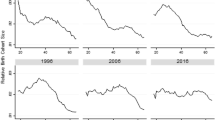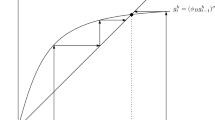Abstract
Motivated by empirical evidence that fluctuations in age structure affect relative wages across age groups, this paper asks whether there is a steady-state age distribution that maximizes the lifetime wages of a representative worker. The paper proves the surprising result that in a pure labor economy with any constant returns technology, a uniform age distribution minimizes lifetime wages. Skewed age distributions, generated by either positive or negative population growth rates, generate unambiguously higher lifetime wages than a stationary population, in spite of possible reductions in per capita output in every period. The presence of non-labor factors complicates, but does not necessarily reverse, this result. The paper relates the beneficial effects of higher rates of population growth on lifetime wages in a pure labor economy with imperfect substitutability across age groups to the benefits of population growth that appear in overlapping-generation consumption loan models with intergenerational transfers.
Similar content being viewed by others
References
Arthur WB (1981) The ergodic theorems of demography: a simple proof. Demography 19:439–445
Arthur WB, McNicoll G(1977) Optimal time-paths with age dependence: a theory of population policy. Rev Econ Studies 44:111–123
Arthur WB, McNicoll G (1978) Samuelson, population and intergenerational transfers. Int Econ Rev 19:241–246
Berger MC (1985) The effect of cohort size on earnings growth: a reexamination of the evidence. J Polit Econ 93:561–573
Berger MC (1989) Demographic cycles, cohort size, and earnings. Demography 26:311–321
Bloom DE, Freeman RA, Koremnan SD (1980) The labour-market consequences of generational crowding. Eur J Popul 3:131–176
Coale AJ (1972) The growth and structure of human populations: a mathematical investigation. Princeton University Press, Princeton
Connelly R (1986) A framework for analyzing the impact of cohort size on education and labor earnings. J Hum Resources 21:543–562
Deardorff A (1976) The optimum growth rate for population: comment. Int Econ Rev 17:510–515
Dooley MD, Gottschalk P (1984) Earnings inequality among males in the U.S.: trends and the effect of labor force growth. J Polit Econ 92:59–89
Easterlin RA (1978) What will 1984 be like? Socioeconomic implications of recent twists in age structure. Demography 15:397–432
Falaris EM, Peters HE (1988) Fertility, female labor supply, and the demographic cycle. Presented at IUSSP Seminar on The Family, The Market, and The State in Aging Societies, Sendai, Japan
Freeman R (1979) The effect of demographic factors on age-earnings profiles. J Hum Resources 14:289–318
Keyfitz N (1977) Applied mathematical demography. Wiley and Sons, New York
Lam D (1984) The variance of population characteristics in stable populations, with applications to the distribution of income. Popul Studies 38:117–127
Lee R (1980) Age structure, intergenerational transfers, and economic growth. Rev Econ 31:1129–1156
Lee R, Lapkoff S (1988) Intergenerational flows of time and goods: consequences of slowing population growth. J Polit Econ 96:618–651
Nerlove M, Razin A, Sadka E (1987) Household and economy: welfare economics of endogenous fertility. Academic Press, Boston
Preston S (1982) Relations between individual life cycles and population characteristics. Am Sociol Rev 47:253–264
Samuelson P (1958) An exact consumption-loan model of interest with or without the social contrivance of money. J Polit Econ 66:467–482
Samuelson P (1975) The optimum growth rate for population. Int Econ Rev 16:531–538
Samuelson P (1976) The optimum growth rate for population: agreement and evaluations. Int Econ Rev 17:516–525
Solow R (1956) A contribution to the theory of economic growth. Q J Econ 79:65–94
Stapleton DS, Young DY (1984) The effects of demographic change on the distribution of wages, 1967–1990. J Hum Resources 19:175–201
Stapleton DS, Young DY (1988) Educational attainment and cohort size. J Labor Econ 6:330–361
Welch F (1979) Effects of cohort size on earnings: the baby boom babies' financial bust. J Polit Econ 87:S65-S97
Willis R (1982) The direction of intergenerational transfers and demographic transition: the Caldwell hypothesis reexamined. Popul Dev Rev 8(Suppl):207–234
Willis R (1987) Externalities and population. In: Gale Johnson D, Lee RD (eds) Population growth and economic development: Issues and evidence. University of Wisconsin Press, Madison, pp 661–702
Author information
Authors and Affiliations
Additional information
A previous version of this paper was presented at the Economic Demography Workshop at the 1988 meetings of the Population Association of America. Helpful comments from Mark Berger, Theodore Bergstrom, Ronald Lee, Hal Varian, and Robert Willis are acknowledged.
Rights and permissions
About this article
Cite this article
Lam, D. Population growth, age structure, and age-specific productivity. J Popul Econ 2, 189–210 (1989). https://doi.org/10.1007/BF00177323
Received:
Accepted:
Issue Date:
DOI: https://doi.org/10.1007/BF00177323




